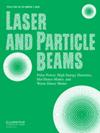用等离子体韦克菲尔德操纵激光驱动质子束
IF 1.9
4区 物理与天体物理
Q4 PHYSICS, APPLIED
引用次数: 0
摘要
激光质子加速器具有持续时间短、亮度高的优点,在工业、医疗和科研等诸多领域显示出巨大的应用潜力。然而,当前激光驱动质子束的质量,如能量分布广和发散角大,仍然是一个挑战。我们用数值模拟研究了质子束在等离子体中的传播。结果表明,该束会激发尾流场并进行自我调制。虽然尾流场不能控制束头的少数粒子,但总能量传播减小了。此外,尾流场在减小纵向能量扩散的同时,也会在横向挤压光束。束束的空间电荷效应被尾流场完全抵消,束束的横向动量随着束束在等离子体中的传输而减小。对于激光驱动离子束,我们的研究为离子束的优化提供了一种新的思路。本文章由计算机程序翻译,如有差异,请以英文原文为准。
Manipulating the Laser-Driven Proton Bunch with Plasma Wakefield
With the advantages of short duration and extreme brightness, laser proton accelerators (LPAs) show great potential in many fields for industrial, medical, and research applications. However, the quality of current laser-driven proton beams, such as the broad energy spread and large divergence angle, is still a challenge. We use numerical simulations to study the propagation of such proton bunches in the plasma. Results show the bunch will excite the wakefield and modulate itself. Although a small number of particles at the head of the bunch cannot be manipulated by the wakefield, the total energy spread is reduced. Moreover, while reducing the longitudinal energy spread, the wakefield will also pinch the beam in the transverse direction. The space charge effect of the bunch is completely offset by the wakefield, and the transverse momentum of the bunch decreases as the bunch transports in the plasma. For laser-driven ion beams, our study provides a novel idea about the optimization of these beams.
求助全文
通过发布文献求助,成功后即可免费获取论文全文。
去求助
来源期刊

Laser and Particle Beams
PHYSICS, APPLIED-
CiteScore
1.90
自引率
11.10%
发文量
25
审稿时长
1 months
期刊介绍:
Laser and Particle Beams is an international journal which deals with basic physics issues of intense laser and particle beams, and the interaction of these beams with matter. Research on pulse power technology associated with beam generation is also of strong interest. Subjects covered include the physics of high energy densities; non-LTE phenomena; hot dense matter and related atomic, plasma and hydrodynamic physics and astrophysics; intense sources of coherent radiation; high current particle accelerators; beam-wave interaction; and pulsed power technology.
 求助内容:
求助内容: 应助结果提醒方式:
应助结果提醒方式:


